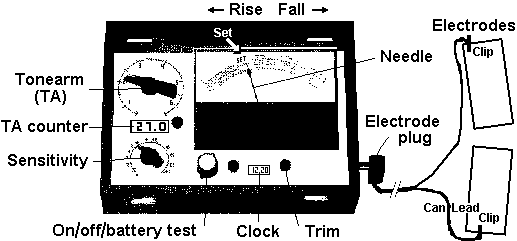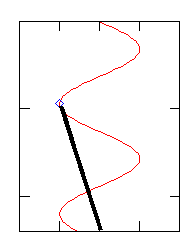
Meter Terms
|
Needle Characteristics |
|
|
Needle |
Definition |
| 1. Stuck Needle | A totally stuck needle
means the needle looks stiff and unmoving. The needle wouldn't even react
to the
pc being pinched. It simply means that the pc has flowed out or flowed in too
long in one direction. Stuck needle means: Betrayal, anger, stopped or stopping, hate, fixed attention, failed help, refused help, terror, and failure. (EM-16) |
| 2. Null (X) | Needle doesn't get a change of pattern or a reaction on the question. The needle continues to behave the same, uninfluenced by the auditing question. |
| 3. Falls | Needle moves instantly to right. Means a disagreement
with life, on which the preclear has some reality, has met the question
asked. Falls mean: Losses, lies, present time problems, Locks, and disagreements with a reality. (EM-16) |
| A. Small Fall (sF) | Smaller instant movement of needle to the right 1.25 - 2.5 cm (1/2 -1"). |
| B. Fall (F) | Instant movement of needle to the right 2.5-5 cm (1-2"). |
| C. Long Fall (LF) | Longer instant movement of needle to the right 5-8 cm (2-3"). |
| D. Long Fall Blowdown (LFBD) | An instant long fall followed by a Blowdown ( TA motion downward). The TA has to be adjusted to a lower position to keep needle on 'Set'. Sometimes defined as 0.2 divisions downward motion. |
| 4. Tick (T) | A 'fall' smaller than a SF. Smaller than 1.25 cm (1/2"). |
| 4. Change of Characteristic | The question or item alone changes the needle pattern, we must assume that something is there. It can be explored with 'buttons' to develop a valid read. |
| 5. Rise | A steady constant movement of the
needle from right to left. It means "no confront." Pc has struck
something he isn't confronting. One never calls pc's attention to this,
but should know what it is. A rise means: Non-confront, an ARC break restimulation, unreality, out-of-sessionness, fear, irresponsibility, identification. elsewhereness, dispersal, and confusion. (EM-16) |
| 6. Theta Bop | A steady dance of the needle. Small or wide.
Between 3 mm (1/8") wide or up to 1.5 cm (1/2") wide. (depends
on sensitivity setting). It goes up and down 5-10 times a second. It moves
up, sticks, moves down, sticks and always the same distance. Constant distance
and speed. Theta bop means: Exteriorizations, operations, desires to leave anything, violent injuries, and shocks. |
| 7. Rock Slam (R/S) | Rock Slam: The crazy, irregular, left-right
slashing motion of the needle on the Meter dial. R/S'es repeat left and
right slashes unevenly and savagely, faster than the eye easily follows.
The needle is frantic. The with of a R/S depends largely on sensitivity
setting. It goes from 3/4 cm (1/4") to the whole dial. But it slams
back and forth. Valid R/S'es are not always instant reads. A R/S can
read prior or latently. A R/S means a hidden evil intention on the subject in question or under discussion. |
| 8.
Free Needle/ Floating needle (F/N) |
A floating needle is a
harmonic motion over the dial
at a slow, even pace of the needle.
(TA position not part of definition). It ceases to register on the pc's Bank. With VGIs in on pc, it means 'release'. It can occur after a cognition, LFBD or just move into floating. |
| 8A. ARC Break needle (ARCxFN) | A Needle can look like an F/N but be caused by an ARC break. The pc will have Bad Indicators. It is never indicated to pc. An ARC Break can also cause a Stuck or sticky needle. |
| 9. Instant FN | An instant F/N is an F/N which occurs instantly at the end of the major thought voiced by the auditor or at the end of the major thought voiced by the pc (when pc originates items or tells what the command means). It usually occurs as LF-FN or LFBD-FN. An instant F/N on an item means charge has just keyed-out on that item, and that it can key back in again. The use of an F/N as a read is almost entirely left to the next C/S except when used in Engram running. |
| 10. Stage four | Needle goes up 2.5-5 cm (1-2") then
sticks for a moment. Dips down in a sweep, then back up and sticks again.
Always the same distance and with great regularity. Nothing you say or the pc
says changes that. It means the pc is in bad shape as a case, "all mental machinery". |
| 11. Rocket read (RR) | Needle takes off. It always goes to the right. It takes off with a very fast spurt and does a rapid slow down. It's very fast. |
| 12. A clean needle | Needle acts when the auditor speaks and does nothing the rest of the time. Can move slowly with no ticks or pattern in it. |
| 13. A dirty needle (DN) |
An erratic agitation of the needle which is
ragged, jerky, ticking, not sweeping; it tends to persist. it is not
limited in size. A DN is caused by one of three things |
| 14. Speeded rise | The needle is rising slowly and suddenly more quickly caused by an additional thing in the 'rise' category going into effect. |
| 15. Speeded fall | The needle is falling slowly and suddenly more quickly caused by an additional thing in the 'fall' category going into effect. |
| 16. Slowed rise | A rise slows down suddenly, yet continues as a rise. |
| 17. Slowed fall | A fall slows down suddenly, yet continues as a fall. |
| 18. Stop | A moving needle (rise/fall) comes to a stop. |
| 19.
Body reactions/ Body motion |
Deep breathing, a sigh, a yawn or sneeze and a couple of other things can make the needle react. Should be studied and eliminated as valid reads. |
| 20. Instant Read | That reaction of the needle which occurs at the precise end of any Major Thought voiced by the auditor or at the end of the major thought voiced by the pc (when pc originates items or tells what the command means). |
| 21.Latent Read | A read that occurs too late to be an instant read. |
| 22. Prior Read | A read that occurs too early to be an instant read. |
| Major Thought | Means the complete thought of an auditing question or command being expressed in words by the auditor. |
| Meter Steering | If a question has an Instant read, but pc
can't answer it, the auditor can say "That...that...that" each
time a duplicate read occurs and the pc will find it. This is the only valid use of latent reads in processes; it repeats an instant read. |
| Minor Thought | Sub-thoughts expressed by words within the major thought. Example: "Have you ever injured dirty pigs?" To the pc the words "you," "injured," and "dirty" are all reactive. Therefore, the minor thoughts in these words also read on the Meter. These reads are not used in normal auditing. |
| Can Squeeze | Meter test performed with pc on the cans. Sensitivity is adjusted so a gentle squeeze gives 1/3 of a dial drop of needle. That will be the right sensitivity for the session (see EM-5A). |
| Metabolism test | Pc takes a deep breath and exhales. It should give a latent LF. It shows the pc is well fed and will read well on the Meter (EM-5B). |
Simple
Harmonic Motion  |
The
back and forth swing of a Floating needle. In physics this motion is
called a simple harmonic motion, the smooth swing of a pendulum or a
metronome. It is graphed on the shown curve, a so-called sine curve.
|
|
Other Meter Terms |
|
|
Term |
Definition |
| Calibration | The process of tuning the Meter so TA 3.0 = 12.500 Ohms and TA 2.0 = 5.000 Ohms. Resistors of these values are inserted in the can clips and the Meter tested occasionally for accuracy. |
| Male Clear Read | A male body with no mental mass reads at TA=3.0 |
| Female Clear Read | A female body with no mental mass reads at TA=2.0 |
| 12,500 Ohms resistor | This is the technical value of TA=3.0. A resistor is used to check the accuracy of this TA position on the Meter. |
| 5,000 Ohms resistor | This is the technical value of TA=2.0. A resistor is used to check the accuracy of this TA position on the Meter. |
| Trim Check | Without the cans plugged in and needle on 'Set' the TA position should be 2.0. This is checked before session and Meter adjusted. After session any difference is noted as a check. |
| Trim Knob | The little knob used in adjusting the needle position in a trim check. |
| Low TA | TA position below 2.0. Can be false TA or be caused by overwhelm. |
| High TA | TA position above 3.0 (sometimes stated above 3.5) |
| Tone Arm (TA) | The biggest knob on the face of the Meter. In auditing its position indicates amount of mental mass in restimulation on the case. |
| False TA | The Tone Arm can show too low or too high a reading due to dry or wet hands and other factors, all related to physical causes, rather than pc's case. |
| TA | The Tone Arm. Is sometimes used to mean TAA (Tone Arm Action).. |
| TA Dial | The scale that gives the TA its numerical value. It goes from 0.5 to 6.5 on most Meters. |
| TA Action
(TAA) (Also TA) |
Is measured by divisions down per hour of auditing. TA action is not counted by up and down, only downward motion is used. Good TAA means the pc is making case gains. |
| TA Counter | Counter built into Meter that measures total downward TA motion. |
| Needle Dial | The most visible scale on the face of the Meter on which the needle moves. The middle of this scale has a mark for 'Set'. |
| Set Position | A mark on the Needle Dial that is used in adjusting the Needle position. Keeping the Needle near Set simply means that any movement up or down will be visible immediately. |
| Electrodes | The 'cans' the pc holds in his hands to make electrical contact with the Meter. Sometimes made specifically for auditing. |
| Cans | The common name for the electrodes, as common soup cans most often are used and work very well. |
| Jack/ Electrode Plug |
The electrical plug that connects the can lead with the Meter box. It's mounted at the end of the can leads. |
| Jack Socket/ Plug Socket |
The jack goes into the jack socket that is built into the Meter box. |
| Alligator Clips | Small electrical clips used to attach the cans to the leads. |
| Can Lead | The electrical wire that connects the cans to the Meter. |
| Battery | A Meter usually has a rechargeable battery built into it (typically 6-9 Volts). |
|
Home Search Level 0 Level 1 Level 2 Level 3 Level 4 Level 4Pro Level 5 C/Sing Solo |
|
|
| Tech terms | Scales | Axioms | Drills | Checksheets | Processes | Prep. lists | C/S terms | C/S tool | Grades | Cramm | Points | KTW | Online | |